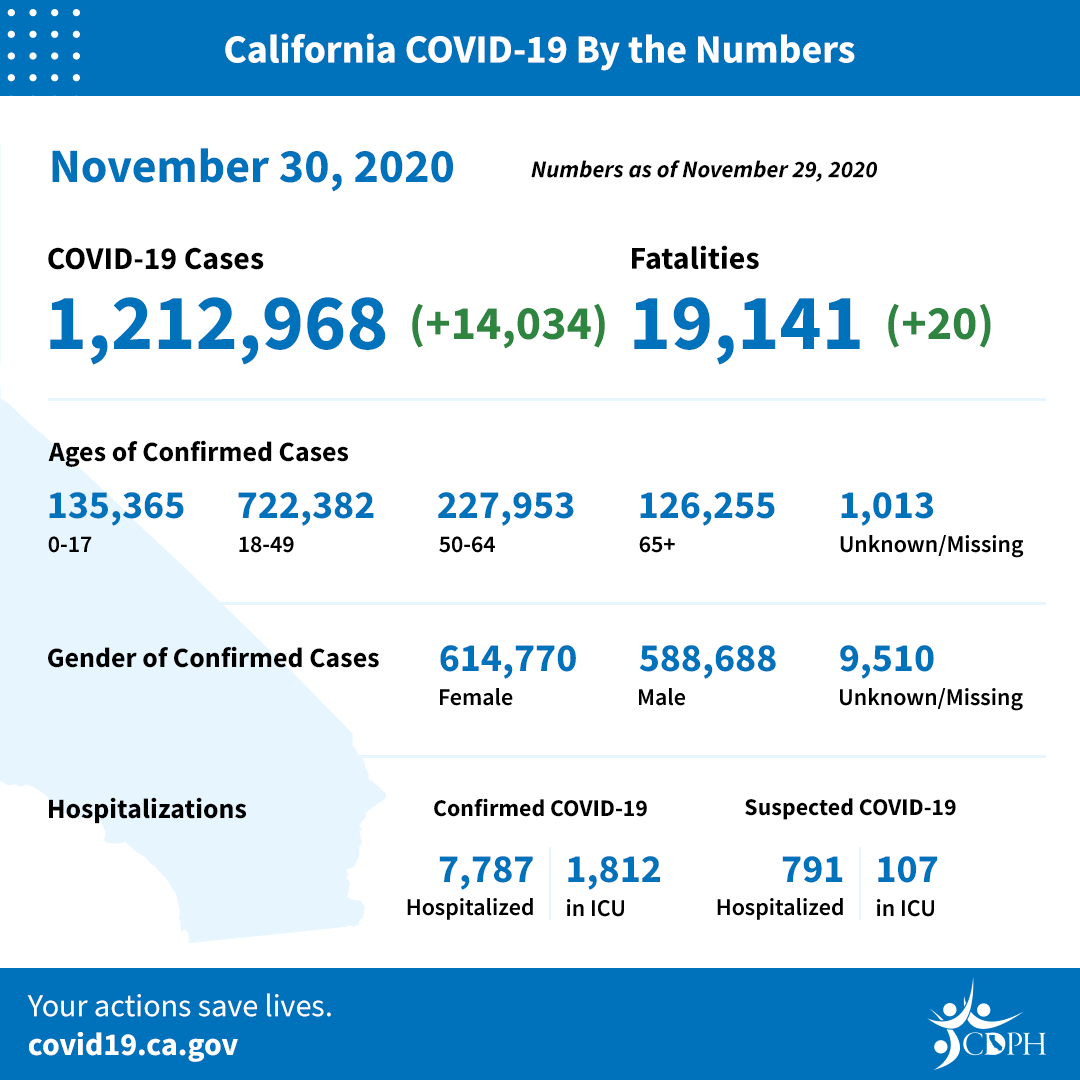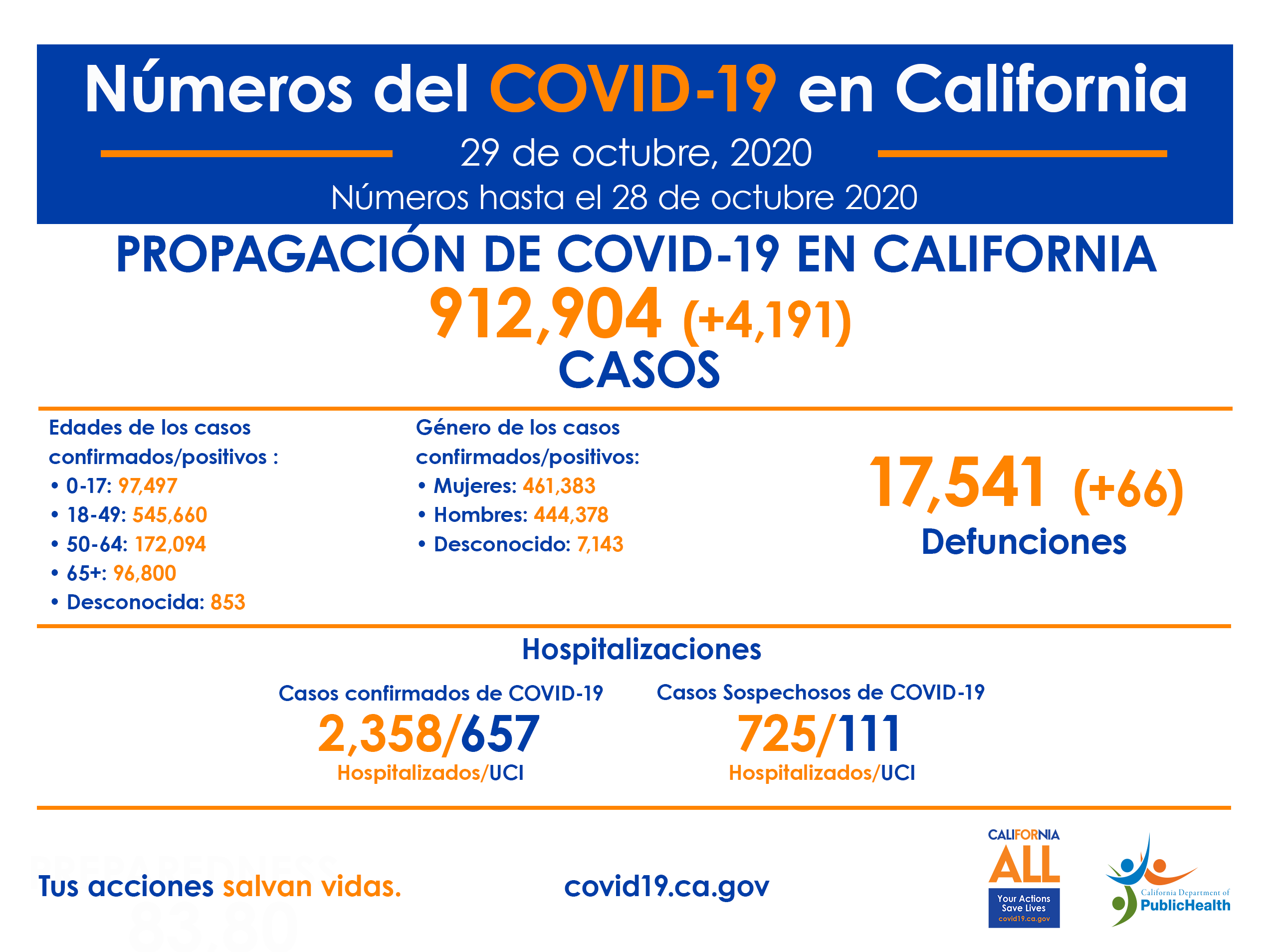State Officials Announce Latest COVID-19 Facts
Date: November 30, 2020
Number: NR20-318
Contact: CDPHpress@cdph.ca.gov
SACRAMENTO – The California Department of Public Health (CDPH) today announced the most recent statistics on COVID-19.
- California has 1,212,968 confirmed cases to date. Numbers may not represent true day-over-day change as reporting of test results can be delayed.
- There were 14,034 newly recorded confirmed cases Sunday. Numbers do not represent true day-over-day change as these results include cases from prior to yesterday.
- The 7-day positivity rate is 6.5% and the 14-day positivity rate is 6.2%.
- There have been 24,025,171 tests conducted in California. This represents an increase of 217,670 over the prior 24-hour reporting period.
- As case numbers continue to rise in California, the total number of individuals who will have serious outcomes will also increase. There have been 19,141 COVID-19 deaths since the start of the pandemic.

Testing Turnaround Time
The testing turnaround dashboard reports how long California patients are waiting for COVID-19 test results. California has worked to reduce testing turnaround times in recent weeks to help curb the spread of the virus. During the week of
November 15 to November 21, the average time patients waited for test results
was 1.4 days. During this same time period, 59 percent of patients received
test results in 1 day and 86 percent received them within 2 days. The testing turnaround time dashboard (PDF) is updated weekly. At this time, all four tiers in the Testing Prioritization Guidance originally dated July 14, 2020, will have equal priority for testing.
Blueprint for a Safer Economy
Governor Gavin Newsom unveiled the Blueprint for a Safer Economy, a statewide plan for reducing COVID-19 and keeping Californians healthy and safe. The plan imposes risk-based criteria on tightening and loosening COVID-19 allowable activities and expands the length of time between changes to assess how any movement affects the trajectory of the disease.
Californians can go to covid19.ca.gov to find out where their county falls and what activities are allowable in each county.
Data and Tools
A wide range of data and analysis guides California’s response to COVID-19. The state is making the data and its analytical tools available to researchers, scientists and the public at covid19.ca.gov.
Popular links include:
Multisystem Inflammatory Syndrome in Children (MIS-C)
Each week, the California Department of Public Health updates the number of cases of Multisystem Inflammatory Syndrome in Children (MIS-C) reported in the state. As of November 23, 136 cases of MIS-C have been reported statewide. To protect patient confidentiality in counties with fewer than 11 cases, we are not providing total counts at this time.
MIS-C is a rare inflammatory condition associated with COVID-19 that can damage multiple organ systems. MIS-C can require hospitalization and be life threatening. Parents should be aware of the signs and symptoms of MIS-C including fever that does not go away, abdominal pain, vomiting, diarrhea, neck pain, rash, bloodshot eyes or feeling tired. Contact your child's doctor immediately if your child has these symptoms. Early diagnosis and treatment of patients is critical to preventing long-term complications.
Racial Demographics – A More Complete Picture
The California Department of Public Health is committed to health equity and collecting more detailed racial and ethnic data that will provide additional understanding for determining future action. Health outcomes are affected by forces including structural racism, poverty and the disproportionate prevalence of underlying conditions such as asthma and heart disease among Latinos and African American Californians. Only by looking at the full picture can we understand how to ensure the best outcomes for all Californians.
The differences in health outcomes related to COVID-19 are most stark in COVID-19 deaths. We have nearly complete data on race and ethnicity for COVID-19 deaths, and we are seeing the following trends: Latinos, African Americans, Native Hawaiians and Pacific Islanders are dying at disproportionately higher levels. More males are dying from COVID-19 than females, in line with national trends. More information is available at COVID-19 Race and Ethnicity Data.
Health Care Worker Infection Rates
As of November 29, local health departments have reported 52,729 confirmed positive cases in health care workers and 218 deaths statewide.
Your Actions Save Lives
California is experiencing the fastest increase in cases we have seen yet – faster than what we experienced at the outset of the pandemic and this summer. If COVID-19 continues to spread at this rate, it could quickly overwhelm our health care system and lead to catastrophic outcomes. Protect yourself, family, friends and community by following these prevention measures:
- Staying home except for essential needs/activities and following local and state public health guidelines when visiting businesses that are open.
- Following the limited Stay at Home Order that requires all non-essential work and activities to stop between 10 p.m. and 5 a.m. in counties in the purple tier. The order took effect at 10 p.m. Saturday, November 21, and will remain in effect until 5 a.m. December 21.
- Staying close to home, avoiding non-essential travel, and practicing self-quarantine for 14 days after arrival if you leave the state.
- Keeping gatherings small, short and outdoors and limiting them to those who live in your household.
- Wearing a cloth face mask when out in public.
- Washing hands with soap and water for a minimum of 20 seconds.
- Avoiding touching eyes, nose or mouth with unwashed hands.
- Covering a cough or sneeze with your sleeve, or disposable tissue. Wash your hands afterward.
- Avoiding close contact with people who are sick.
- Staying away from work, school or other people if you become sick with respiratory symptoms like fever and cough.
- Answer the call if a contact tracer from the CA COVID Team or your local health department tries to connect. Contact tracers will connect you to free, confidential testing and other resources, if needed.
- Following guidance from public health officials.